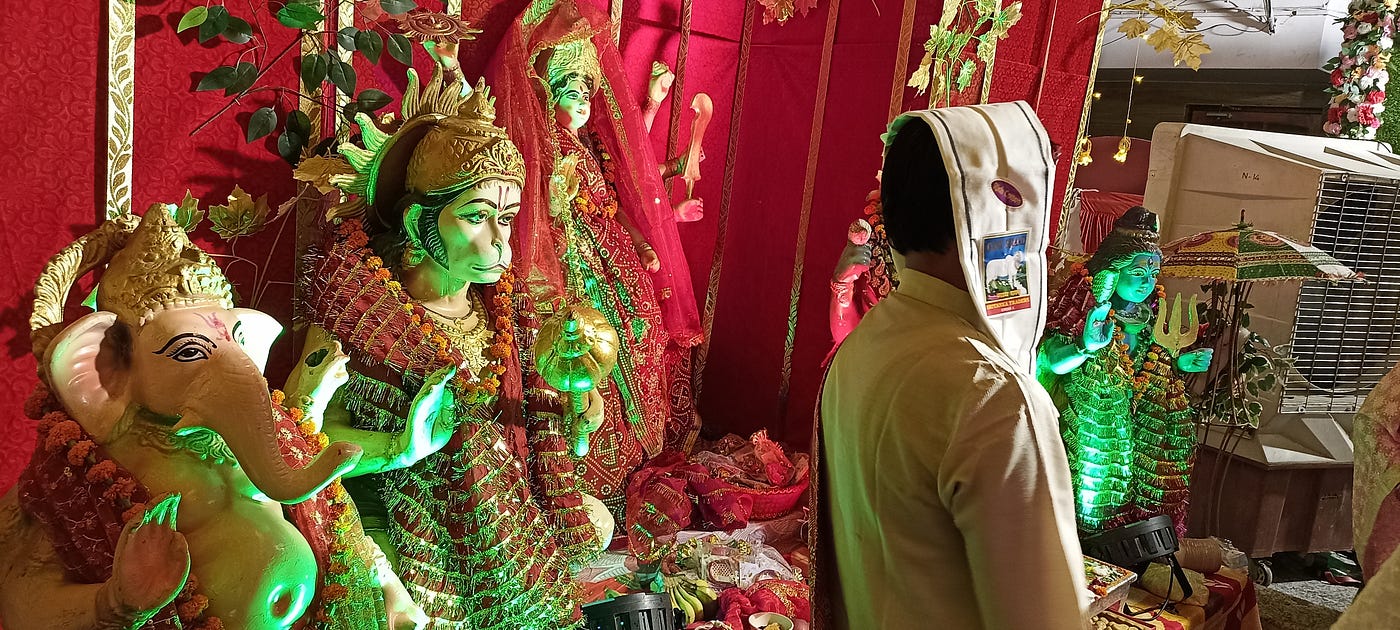In the rich tapestry of Sanatan Dharma, bhajan sandhya and kirtan hold a special place as powerful spiritual practices. These devotional activities not only enhance personal spiritual experiences but also strengthen communal bonds through shared worship. This blog explores the significance, practice, and impact of bhajan sandhya and kirtan, offering insights into how these forms of devotional music contribute to spiritual upliftment and inner peace.
What is Bhajan Sandhya?
Bhajan Sandhya is an evening gathering dedicated to singing devotional songs or bhajans. “Bhajan” means a devotional song that praises deities or spiritual concepts, while “sandhya” refers to the evening time. Bhajan Sandhya typically takes place at dusk, symbolizing the transition from day to night, and it creates a serene atmosphere conducive to spiritual reflection and connection.
The Essence of Bhajan Sandhya
Devotional Expression
Bhajan Sandhya serves as a collective expression of devotion and reverence. The songs, often composed in praise of various deities, convey deep spiritual sentiments and foster a sense of unity among participants. The act of singing together helps to transcend individual concerns and focus on divine love and worship.
Creating Sacred Space
The evening setting of Bhajan Sandhya is significant, as it creates a tranquil environment ideal for spiritual activities. The transition from daylight to twilight symbolizes a shift from the mundane to the sacred, enhancing the spiritual atmosphere and providing a sense of calm and introspection.
Community Bonding
Bhajan Sandhya often brings together individuals from various walks of life, creating a sense of community and shared purpose. This collective worship strengthens social ties and fosters a supportive spiritual network, enhancing the sense of belonging and collective spiritual growth.
The Practice of Bhajan Sandhya
Setting the Atmosphere
Bhajan Sandhya typically begins with creating a peaceful environment. This may involve lighting lamps or candles, offering flowers, and preparing a simple altar. The atmosphere is enhanced by calming music and the setting of a devotional mood.
Performing Bhajans
The core of Bhajan Sandhya is the singing of bhajans. These devotional songs can vary in style, from traditional compositions to contemporary melodies, and are often accompanied by instruments such as harmoniums, tablas, and cymbals. The lyrics of bhajans focus on divine attributes, stories from sacred texts, or expressions of devotion.
Meditation and Reflection
While the bhajans are sung, participants engage in meditation and reflection. The rhythmic and melodic nature of the songs helps to center the mind, allowing for deeper contemplation and spiritual connection. The process of singing and listening together creates a meditative experience that calms the mind and opens the heart.
What is Kirtan?
Kirtan is a form of devotional music that involves the call-and-response chanting of hymns or mantras, typically focused on praising deities or spiritual principles. Derived from the Sanskrit word “kirt,” meaning “to praise” or “to tell,” kirtan is both a musical and spiritual practice that engages participants in a dynamic and interactive manner.
The Essence of Kirtan
Interactive Worship:
Kirtan is characterized by its interactive nature, where a lead singer or musician chants a line or mantra, and the congregation responds in unison. This call-and-response format creates a lively and participatory atmosphere, fostering a sense of communal involvement and spiritual engagement.
Spiritual Upliftment
The repetitive and rhythmic chanting in kirtan has a meditative effect, helping to elevate consciousness and foster spiritual experiences. The mantras and hymns used in kirtan are believed to have divine vibrations that connect participants with higher spiritual realms.
Joyful Expression
Kirtan is often performed with enthusiasm and joy, reflecting the belief that devotion should be a source of happiness and celebration. The uplifting nature of kirtan encourages participants to express their devotion freely and experience spiritual bliss through music and chanting.
The Practice of Kirtan
Preparation
Kirtan sessions typically begin with setting up a simple space for worship, often involving a small altar, musical instruments, and comfortable seating. The atmosphere is designed to be welcoming and conducive to collective participation.
Chanting and Music
The practice of kirtan involves chanting sacred mantras, hymns, or verses from spiritual texts. The lead singer or musician initiates the chant, and the congregation responds with enthusiasm. Instruments such as harmoniums, tablas, and mridangams accompany the chanting, adding rhythm and depth to the experience.
Engagement and Participation
Participants in kirtan are encouraged to join in the chanting, clapping, and dancing. The interactive nature of kirtan promotes a sense of communal spirit and shared devotion. The experience is often marked by a feeling of connection and joy, enhancing the overall spiritual experience.
The Impact of Bhajan Sandhya and Kirtan
Spiritual Growth:
Both Bhajan Sandhya and Kirtan contribute to spiritual growth by providing opportunities for deepening one’s connection with the divine. The practice of singing devotional songs and participating in kirtan fosters a sense of inner peace, clarity, and spiritual fulfillment.
Emotional Well-being
The act of participating in Bhajan Sandhya and Kirtan can have therapeutic effects, reducing stress and promoting emotional well-being. The soothing melodies and rhythmic chants create a calming effect, helping to alleviate anxiety and enhance emotional stability.
Community Building
These devotional practices strengthen communal bonds by bringing people together for a shared spiritual experience. The sense of unity and collective devotion nurtures a supportive community and fosters mutual respect and understanding.
Conclusion
Bhajan Sandhya and Kirtan are profound practices that enrich spiritual life through music and collective worship. Bhajan Sandhya, with its focus on evening devotional songs, creates a serene space for reflection and communal worship. Kirtan, with its dynamic call-and-response chanting, fosters interactive and joyful spiritual engagement. Together, these practices offer a pathway to spiritual growth, emotional well-being, and community cohesion. By participating in Bhajan Sandhya and Kirtan, individuals and communities can experience the transformative power of devotional music and deepen their connection with the divine.

